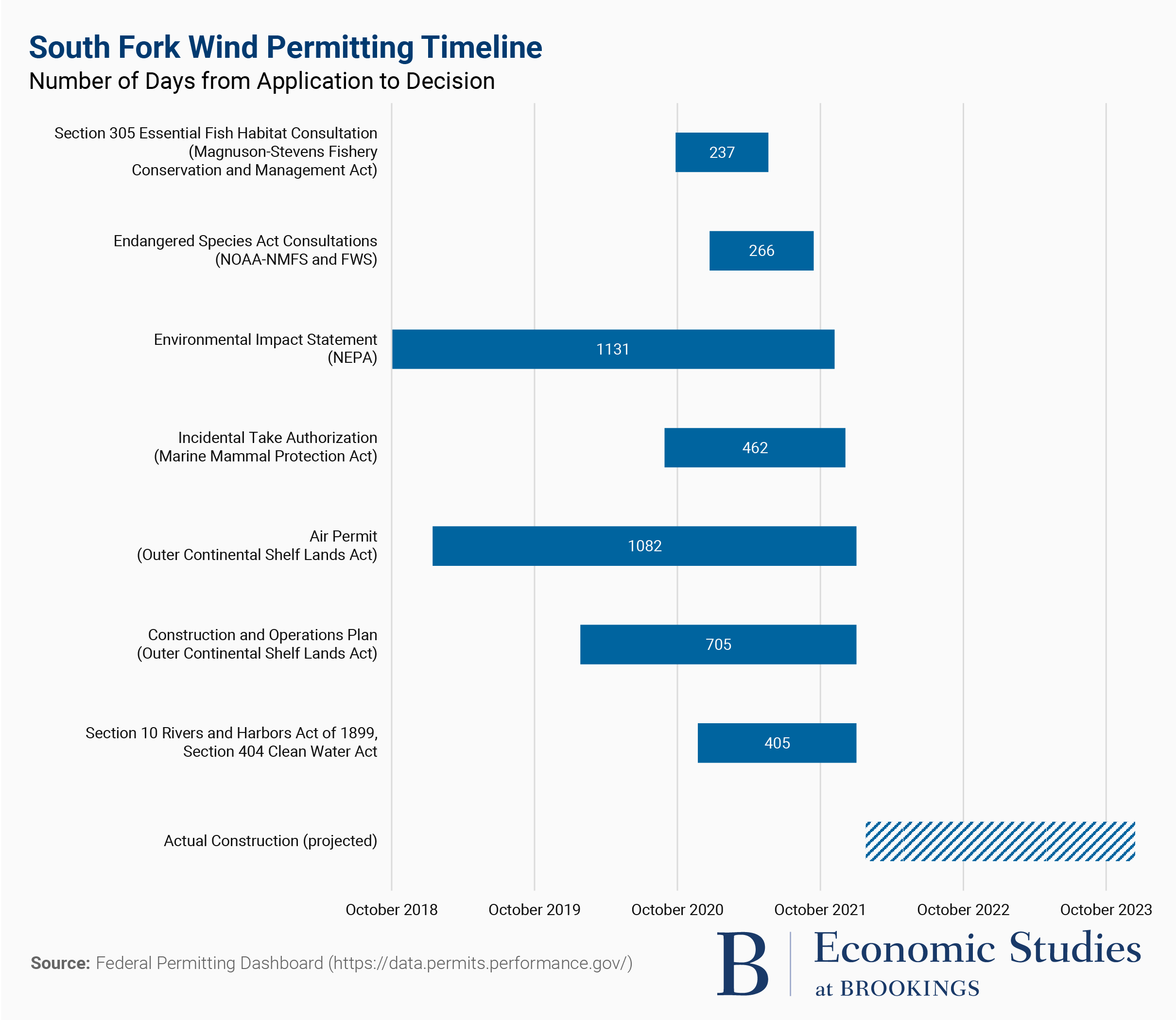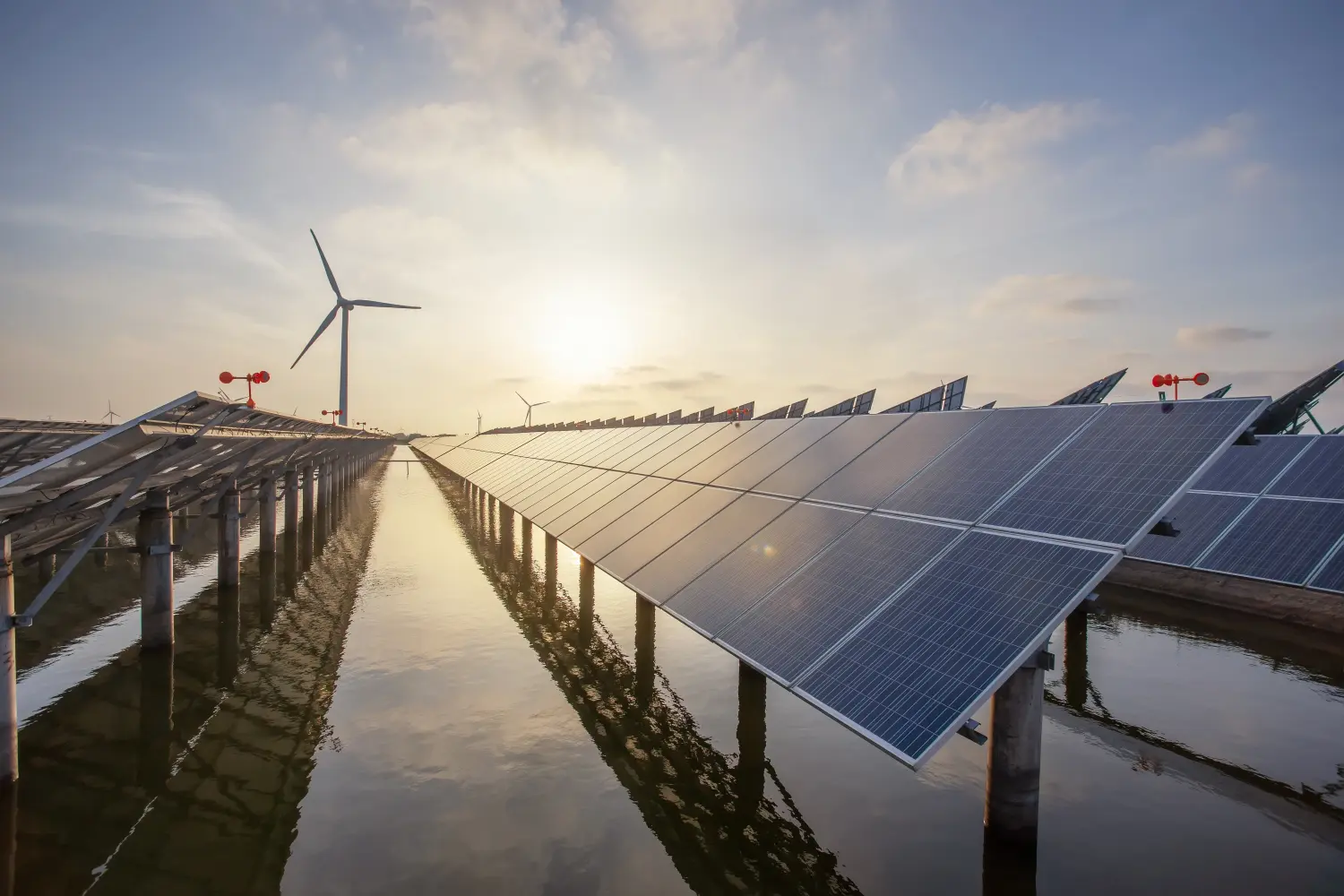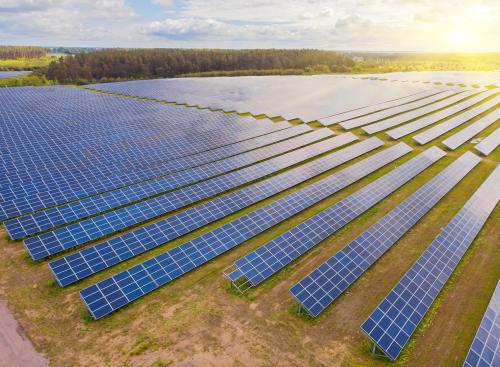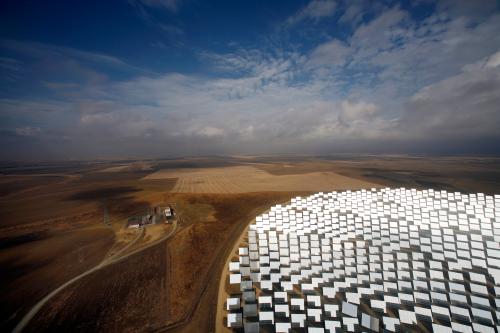Introduction
The Biden administration has set a target of reducing greenhouse gas emissions to half of 2005 levels by 2030 and to net zero by 2050. To meet these targets the United States will have to quickly build a vast amount of clean energy infrastructure, replacing fossil fuel powered electricity generation with renewable sources of electricity like wind and solar. In addition, direct consumption of fossil fuels such as gasoline-powered cars and gas-powered heating will have to be electrified and powered by the new clean electric grid. These factors combined mean that to achieve the Biden administration’s targets, the electric grid needs to be expanded by at least 60% by 2030, and electricity demand may nearly double by 2050.
Such a rapid expansion of the renewable electricity system would require the quick planning, permitting, and building of renewable energy sources like solar plants and wind farms. It also requires long-distance electric transmission lines to transport clean energy from sparsely populated areas where it is abundant to the urban centers where it is sorely needed.
There are many obstacles to the rapid deployment of this infrastructure, but one key obstacle at the center of much debate is the federal permit process. As part of recent negotiations to secure the passage of the Inflation Reduction Act (IRA), Senator Joe Manchin made a “side deal” with Democratic leaders. In this deal, he made his critical support for the IRA contingent on the passage of an energy infrastructure permit reform bill, which, among other provisions, aims to speed the processes of federal permitting by setting time limits on environmental reviews, prioritizing certain big-ticket projects, and limiting state powers in permitting related to electric transmission and clean water protection (although Sen. Manchin pulled this bill from immediate must-pass legislation, his proposed reforms may return to the Senate floor at a later time).
Republicans and Democrats generally agree that the federal permitting process requires reform
Permitting reform such as Senator Manchin’s would need to clear a 60-vote threshold in the Senate, requiring bipartisan support. Indeed, Republicans and Democrats generally agree that the federal permitting process requires reform, and various efforts were made under Presidents Obama, Trump, and now Biden. Most wind energy projects in the pipeline are stuck in the permitting phase, with just 21% of planned projects currently under construction. Major transmission projects have run into hurdles or been shelved entirely in recent years. In sum, there is a clear and evident need to proceed with ambitious reform of the nation’s energy infrastructure permit system. However, how exactly to proceed is contentious, with varying views from Republicans and Sen. Manchin, to environmentalists and House progressives.
In this article, we examine the current policy landscape of the permitting process, with a focus on renewable energy infrastructure deployment. We evaluate some common obstacles to the permitting of such infrastructure and summarize recent policy action to reform these processes at the federal level.
Existing Permit Requirements
The permitting process for renewable energy projects is multi-layered, and the exact type and number of permits for a particular project depends on its size, geography, technology, and jurisdiction. Broadly, however, most projects require approval from local, state, interstate, and federal authorities.
Most projects require approval from local, state, interstate, and federal authorities
Local
Typically, at the lowest level, a renewable project requires a land-use permit based on the zoning and planning ordinances of the city or county government in which it would be sited. The Department of Energy (DOE) maintains a database of local ordinances regarding wind energy, which can often face significant local opposition due to appearance, noise, and other localized impacts. Even rooftop solar can require a local permit.
More broadly, renewable generation and transmission projects often require the consent of the communities in and around their area of operation. Construction of transmission lines, in particular, often must run through private property, sometimes requiring controversial eminent domain battles to find sites.
State
Depending on the state and size of the project, permits from state-level agencies or Tribal governments may be required as well. For example, the White House Council on Environmental Quality (CEQ) maintains a list of 20 state or regional environmental review laws, which mandate the study of the environmental effects of government actions, including granting permits. As an illustration, California requires the analysis and mitigation of the environmental effects of a project under the California Environmental Quality Act (CEQA), and Illinois requires permits for any project that may pollute the land, water, or air.
In addition to environmental permits, permits may be required from any other arm of state government that a project interacts with. For instance, in California, projects like transmission lines that affect a highway right-of-way require a California Department of Transportation permit. States also generally have jurisdiction over the permitting and siting of electric transmission, including interstate transmission passing through their territory.
Interstate/State
Renewable energy projects also need to connect to the local electric grid, also called a “regional transmission network,” in order to deliver their power to customers. These networks are called Regional Transmission Organizations (RTOs) or Independent System Operators (ISOs) and may exist at the state level (such as the CAISO in California or ERCOT in Texas) or regional level (such as the PJM in the Eastern United States).
A power-generating project requires approval from the transmission network to connect to the grid, creating another “permit” layer for the project. Most transmission networks use a “queue” system, where developers’ interconnection applications are considered sequentially.
Federal
Finally, very large projects may require a wide range of federal permits from a variety of agencies, depending on the project scope. When multiple permits are required, one agency is typically designated as the “lead” and coordinates all permits and consultations with other agencies.
Federal permits fall into several categories. The table shown below categorizes some of the most important ones for renewable energy generation and electric transmission projects, although it is not exhaustive.
| Permit | Description |
|---|---|
| Wildlife Protection | Projects that may affect endangered species, fisheries, any natural body of water, marine mammals, migratory birds, or bald or golden eagles, require a consultation and/or permit. |
| Endangered Species Act Consultation | Consultation with the National Marine Fisheries Service (NMFS) or the U.S. Fish and Wildlife Service (FWS) if any endangered species are affected1 |
| Magnuson-Stevens Fishery Conservation and Management Act, Section 305 Essential Fish Habitat (EFH) Consultation | Consultation with NMFS if any Essential Fish Habitat (EFH) is affected |
| Fish and Wildlife Coordination Act Review | Consultation with FWS or NMFS if any body of water is affected (typically as part of EFH consultation, above) |
| Marine Mammal Protection Act, Incidental Take Authorization | Permit from the NMFS if there may be incidental harassment or injury to any marine mammal |
| Migratory Bird Treaty Act permits | Permit from FWS if any migratory birds are affected |
| Bald and Golden Eagle Protection Permit | Permit from FWS if any bald or golden eagles are affected |
| Air and Water Protection | Projects that may pollute the air or water require special permits |
|
Section 404 of the Clean Water Act, Section 10 of the Rivers & Harbors Act |
Permit from the U.S. Army Corps of Engineers (ACE) for any project affecting waterways, wetlands, or harbors |
| Clean Air Act, Outer Continental Shelf (OCS) Air Permit | Permit from the Environmental Protection Agency (EPA) for projects that may cause offshore air pollution |
| Federal/Protected Land Usage | If a project proposes the use of any federally owned or protected land, a permit is required from the relevant land administering agency. |
| Business Resource Lease | Approval from the Bureau of Indian Affairs (BIA) to lease Native American land for development |
| Service Line Agreement | Approval from the BIA to pass through or access Native American land |
| Wind Energy Evaluation Lease ‐ Indian Lands | Approval from the BIA to lease Native American land for wind energy |
| National Park Service (NPS) Permit | Permit for the use of NPS land |
| Right‐of‐way Authorization | Authorization required for any right-of-way passing through land owned by the Interior Department, whether the Bureau of Land Management (BLM), BIA, or FWS wildlife refuges |
| Special Use Permit (FS) | Permit for the use of U.S. Forest Service land |
| Outgrant Administrative Action | Permit for the use of Department of Defense land |
| Easement Administrative Action (USDA – NRCS) | Permit from the U.S. Department of Agriculture for projects on agricultural lands or wetlands with conservation easements |
| Floodplain Assessment | Permit and assessment from the Federal Emergency Management Agency (FEMA) or a local government, for construction on flood risk areas |
| National Marine Sanctuaries Act permit | Consultation or permit (of multiple different types) for projects in a national marine sanctuary |
|
Construction and Operations Plan, Outer Continental Shelf Lands Act |
Permit for offshore wind construction on the OCS from the Bureau of Ocean Energy Management |
Source: Author’s simplification of Federal Environmental Review and Authorization Inventory
Federal environmental protections
There are an important set of federal permits for environmental protection, including protections for wildlife, air, and water. Drawing their authority from a wave of acts passed in the late 1960s and early 1970s, including the Clean Air Act (1970), Clean Water Act (1972), National Environmental Policy Act (1970), and Endangered Species Act (1973), these form an important layer of permitting for any major project.
Under the Clean Air Act and Clean Water Act, the federal Environmental Protection Agency (EPA) is tasked with regulating air and water pollutants respectively, and any project that may result in such pollution must go through a process of analysis, disclosure, and permitting. Wind projects, and offshore wind in particular, often require Clean Air Act permits. Wind, solar, and transmission projects are all likely to need Clean Air Act and Clean Water Act permits during their construction phases as they entail regular construction pollution.
The National Environmental Policy Act (NEPA) is quite different, although it is most frequently targeted as a source of project delays, especially by conservatives. NEPA does not mandate a separate permit like the other laws mentioned here. Instead, it is a procedural law, requiring an assessment of the environmental impacts of any significant federal action, including any project that the federal government issues a permit for.
Most small and routine actions are exempted from NEPA reviews if they fall under a categorical exclusion. Projects that are not excluded from review must go through an Environmental Assessment, a first-stage evaluation of the environmental impacts of the project. Finally, for major projects that are found likely to have a significant impact, a much longer Environmental Impact Statement (EIS) is required. An EIS involves an important public review and comment period, where affected local communities and larger interest groups (such as industry groups or environmentalist organizations) can make their voices heard. Nearly every major renewable energy project requires a NEPA review.
Notably, however, while agencies are required to consider alternatives2 and mitigation plans to reduce environmental impacts under NEPA, they are not required to take action or make any changes to a project. The NEPA review process is often used as an “umbrella statute” in which obligations under other permitting laws such as the Clean Water Act are folded into the NEPA framework. Further, NEPA reviews can be done concurrently with state reviews like the CEQA.
In addition to these broad protections for the environment, specific environmental protections for wildlife require permits. The Endangered Species Act (ESA) prohibits the killing, capture, or other harassment of any federally-listed endangered or threatened species. Projects that unintentionally or “incidentally” harm these protected species, such as a wind farm that may lead to bird deaths, require a permit. Similar protections exist for migratory birds, marine mammals, bald and golden eagles, and fisheries in general.
Solar, wind, and transmission infrastructure can often have negative effects on biodiversity and run up against wildlife protection requirements.
Solar, wind, and transmission infrastructure can often have negative effects on biodiversity and run up against these wildlife protection requirements. Offshore wind in particular must comply with the additional marine life and bird protection requirements, which can be challenging.
Federal & Protected Land Use
A second category of permitting that includes projects that use or pass through land that is managed by or protected by the federal government requires a permit from the relevant agency.
For example, vast swathes of land in the western United States are managed by the Bureau of Land Management (BLM), the U.S. Forest Service (USFS), and the U.S. Fish and Wildlife Services (FWS). Many of these areas are rich in renewable energy resources, and projects that seek to lease these lands for development need the approval of the managing agency.
Further, developing the transmission to bring energy from the sparsely populated West to urban centers frequently requires passing through some federal land, and obtaining such a right-of-way requires a permit as well. The stringency of the approval process depends on the particular federal land management agency, but FWS-managed wildlife reserves and USFS-managed national forests have more conservation-focused missions than BLM land.
Many existing and planned energy facilities and transmission lines, especially in the West, run through federal land and require management agency permits.
In addition to projects on federally managed land, other types of projects trigger permit requirements due to federal area protections. For example, projects affecting wetlands, waterways, or harbors, require a permit from the US Army Corps of Engineers. This includes all offshore wind projects, which affect harbors, and often includes transmission lines, which may cross over wetlands or waterways.
As an illustrative example of the federal permitting timeline, consider the South Fork Wind project. This 130 MW offshore wind project off the coast of Rhode Island was first proposed in response to a 2015 request for proposals by New York state power authorities. It began its permitting journey with an Environmental Impact Statement under NEPA in October 2018. The EIS process lasted nearly three years, during which permits related to endangered species, fisheries, clean water, clean air, and outer continental shelf construction were initiated and issued. Finally, in January 2022, the Construction and Operations Plan was approved by the Bureau of Ocean Energy Management, and South Fork broke ground in February 2022 with operations expected to begin by the end of 2023.
 Note that this accounting does not include the timeline for state and local permits, nor does it include potential delays from ongoing litigation.
Note that this accounting does not include the timeline for state and local permits, nor does it include potential delays from ongoing litigation.
Existing Obstacles in Permitting
Projects can and do get delayed at any stage of the process
Broadly, the array of permits, consultations, and assessments for any large project can be a challenge. Projects can and do get delayed at any stage of the process—local communities may oppose projects that take over their property or obstruct their views; states may impose high environmental review burdens or block unpopular projects; interstate grid operators are backlogged with connection requests; federal authorities may take years to grant the full range of permits a project requires. In this section, we examine the details of permitting obstacles that a renewable energy project may face.
Just like in the cases of housing or transit development, local communities are often the strongest opponents of renewable energy infrastructure. Concerns over the environment, aesthetics, property rights, or other local issues can affect anything from smaller solar projects to massive transmission projects. These concerns could be voiced through public comment processes, litigation, or advocacy. Many towns and counties are imposing moratoria on renewable development altogether. Some wealthy property owners secure conservation easements to block transmission development through their land. Each route of opposition by local opponents has the potential to slow down or stop a major project.
Local governments can also slow down renewable infrastructure deployment due to internal inefficiencies. For example, local permits for rooftop solar can take a month or longer, cumulatively slowing down solar deployment across the country. Further slowing things down, varying requirements and processes for each local government on the path of a renewable energy project have created a “fragmented” regulatory landscape.
Permitting may also be held up by state-level agencies. For example, two major transmission line projects, the Northern Pass Project in New Hampshire and the New England Clean Energy Connect in Maine were stopped by a state-level committee and a state-level ballot initiative, respectively.3 The Ohio Power Siting Board rejected a proposed wind energy plan in 2021 and may soon reject a proposed solar plant.
State environmental laws can also stall projects, through the review process or their use in litigation by project opponents. Most notably, California’s CEQA, which resembles and sometimes goes beyond NEPA, has been wielded by local opponents to block evidently climate-friendly projects such as more bike lanes, bus rapid transit, and wind turbines.
The interconnection of renewable energy projects to the electric grid has been a major source of delay as well. In addition to capacity and resource shortages, the ‘queue’ system that most grid operators use has created a backlog of applications that has nearly doubled the time required for a successful interconnection from two years to just under four years. An initial backlog in the queue resulted in developers submitting applications earlier and earlier, sometimes in a speculative or exploratory phase, resulting in further expansion of the queue. This vicious cycle has led to the largest grid operator in the U.S. placing a two-year hold on new applications, further delaying new renewable energy projects.
More so than local, state, or regional permitting challenges, however, federal permitting has attracted recent attention. Each of the federal permits mentioned may take months or years to be approved. For example, in one 2018 study on reviews under Section 404 of the Clean Water Act in the West and Southwest, a key permit required for some renewable energy construction took an average of over 400 days to obtain.
As mentioned previously, delays caused by NEPA compliance are a common target for criticism. A 2020 report by the White House CEQ found that the median time for an EIS, the most substantial form of NEPA review, was 3.5 years. Average EIS completion timelines varied significantly between agencies, with Department of Transportation-led EISs taking over 6 years, as compared to Department of Agriculture-led EISs taking a little over 3 years to complete. The DOE reported that its EIS reports between 2003 and 2012 cost a median of $1.4 million to complete. According to a 2020 CEQ report on a sample of final EISs, reviews ran to an average of 661 pages.
The primary causes of long NEPA timelines are in dispute
The primary causes of these long NEPA timelines are in dispute. One line of argument goes that such timelines are simply the necessary diligence required for complex projects. In contrast, among those who agree that NEPA delays need to be addressed, a panel of experts convened by the America 2050 group argued that NEPA delays are largely due to procedural delays in implementation rather than problems with the law itself. It listed several reasons for such delays including disagreements between various project stakeholders, inconsistencies between federal agencies, administrative bottlenecks, and insufficient staff capacity, and overly complex reviews in response to the threat of litigation. Eli Dourado at Utah State University agreed with the last listed reason: that federal agencies prepare overly long and complex EISs to ensure that they have covered all effects and alternatives and are thereby less vulnerable to litigation. This argument is also backed up by evidence showing that the federal government prevails in most NEPA litigation.
Further, once NEPA reviews are complete, litigation on the basis of procedural noncompliance is a common obstruction tactic. A DOE survey from 2001 to 2013 revealed that such litigation includes common claims such as circumventing a required NEPA review, inadequately completing a NEPA review, or otherwise inappropriately applying a NEPA review. For example, litigants may argue that an EIS prepared under NEPA does not adequately consider some reasonable alternatives, does not assess some kind of impact, or otherwise does not completely document the environmental impact of a project.
Litigation can more broadly challenge a range of permits issued for a project. Litigation also often explicitly aims at project delay, which can cause enthusiasm and funding for a project to dry up.
All told, the dizzying array of permits and other regulatory obstacles to renewable energy projects can create extremely long delays. Reports of 10-year or longer timelines for transmission lines are not uncommon, and both solar and wind projects face long permitting delays. Delays in these projects make it more challenging for the United States to reduce emissions to meet time-bound targets and may cause cost increases or even cancellation of a project entirely as investors and developers lose interest.
Recent policy activity
The shortcomings in the United States’ permitting landscape and bipartisan support for quick infrastructure development have generated rare consensus on the need for permitting reform. In addition, Republicans have generally championed permit reform with fossil fuel projects in mind, while some Democrats have embraced it as a means to speed up clean energy projects. Especially in the last decade, a wave of regulatory and legislative activity has attempted to speed federal permitting across the board.
In 2015, as part of a spending bill on transportation called the FAST Act, a provision called FAST-41 to improve “coordination and oversight” by federal agencies reviewing infrastructure projects was enacted.4 Among other provisions, it mandated that federal agencies designate chief review and permitting officers to increase accountability, create a public permitting dashboard to publicly display the progress of all federal permits, and prepare a coordinated permitting plan and timetable for major projects. A Federal Permitting Improvement Steering Council was established to improve the federal environmental review process. The FAST-41 program also limited litigation challenging larger projects, including a two-year statute of limitations on permit-related legal challenges.5
Under President Trump, an array of deregulatory efforts were aimed at reducing environmental permitting requirements. A 2017 These provisions were codified in the 2021 bipartisan infrastructure law, along with a general 200-page limit for most EIS documents.
The Trump administration also weakened requirements under NEPA, limiting the consideration of climate change and other “cumulative effects” in NEPA reviews. However, these changes were rolled back under Biden.
Most recently, the Biden-Harris Permitting Action Plan from May 2022 aims to implement the permit reform provisions from the 2021 bipartisan infrastructure law. While maintaining a commitment to being “guided by the best science” and incorporating input from affected communities, this plan lays out a set of internal reforms to speed federal environmental permitting. The focus areas include improving interagency coordination, setting and tracking timeline goals, improving technical assistance for the permitting process, and increasing permitting agency resourcing.
Transmission-focused efforts
Electric transmission infrastructure has received special attention corresponding to the larger problems facing that sector. As far back as 2009, President Obama produced an agreement to improve inter-agency coordination for transmission permitting on federal land and created a Rapid Response Team for Transmission to fast-track specific projects.
Electric transmission infrastructure has received special attention corresponding to the larger problems facing that sector.
Two major and more recent interventions in transmission permitting came from the bipartisan infrastructure bill of 2021, officially named the Infrastructure Investment and Jobs Act (IIJA), and the Inflation Reduction Act (IRA) of 2022.
The IIJA updated the regulatory framework around transmission line siting to give the federal government a power called “backstop siting authority.” The Federal Energy Regulatory Commission (FERC) can now intervene and issue permits for transmission lines in certain National Interest Electric Transmission Corridors (NIETCs) over the objections of state authorities. It can also use the power of eminent domain to take over the necessary lands for a transmission line except when those lands are owned by a state. This provision is not entirely new—it is an attempt to clarify and restore the FERC’s backstop siting authority initially granted in the Energy Policy Act of 2005 but “effectively ended” by court rulings in 2009 and 2011.
This restored backstop siting authority may be a powerful tool. Researchers at the Niskanen Center have argued that the DOE could use it to better plan transmission corridors and reduce the risk of litigation. Essentially, the researchers propose that the DOE designate “national interest” transmission corridors for specific projects rather than broad areas, reducing the NEPA burden and risk of eminent domain litigation and also pre-empting potential delays at the FERC. However, critics have argued that no new “national interest” transmission corridors are in effect yet and, with the exemption of state lands from FERC’s eminent domain powers, states may still functionally block transmission projects they do not like.
The IRA took a different approach to supporting transmission permitting. It allocated substantial funding for transmission permitting and capacity building, creating a $760 million grant program at the DOE to support state-level siting authorities in “navigating the review and approval process.”
FERC Grid Planning Reform
To address the serious “queue” backlogs at regional grid operators, where power developers’ applications for grid interconnections are often delayed for years, the FERC has proposed a new rule. The FERC regulates the national electric system and has proposed modifying the existing ‘queue’ system to a ‘first-ready, first-served’ clustered queue system.
In effect, the “first-ready, first-served” component of the proposal would eliminate the need to process applications that are not entirely ready to connect to the grid. Developers that lack financing or are otherwise not “ready” would be deprioritized in the application process. The “cluster’ component of the proposal would transform the individualized “queue,” where applications for interconnection are studied one at a time, to a system where groups of nearby proposed applications are considered together. This would help cut down on repetitive studies of the same area of the grid.
Together, the provisions of this rule are expected to overhaul and speed the grid connection process for new renewable projects.
Further reforms contained in the FERC’s proposed rule would impose deadlines for interconnection application studies, with financial penalties for laggards. It would also allow project developers to share a single application if they share a single point of connection to the grid. Finally, the proposed rule would require more long-term transmission planning, and would require that grid operators seek the agreement of state-level entities, regarding their plans to distribute the costs of new transmission lines.
Together, the provisions of this rule are expected to overhaul and speed the grid connection process for new renewable projects.
Conclusion
Despite the wave of recent policy activity on infrastructure permitting and some recent acceleration of environmental reviews under the Biden administration, many challenges remain. The need for an extremely aggressive build-out of renewable energy generation and electric transmission well above historical rates suggests that much more permitting reform for such infrastructure is necessary. The success of massive legislation such as the IRA and, more broadly, of the Biden administration’s emissions reduction targets depend on accelerating the deployment of solar, wind, and transmission facilities. Existing policy actions on permitting reforms have made a welcome start by allocating funding for reviewing agencies, improving coordination, increasing federal authority over transmission, and speeding grid interconnections.
The Brookings Institution is financed through the support of a diverse array of foundations, corporations, governments, individuals, as well as an endowment. A list of donors can be found in our annual reports published online here. The findings, interpretations, and conclusions in this report are solely those of its author(s) and are not influenced by any donation.
-
Footnotes
- Wildlife protection permits are governed either by the National Marine Fisheries Service (NMFS), for oceanic wildlife, or the U.S. Fish and Wildlife Service (FWS) for all other wildlife.
- The scope of this requirement has been a recent political football, removed by Trump and then restored by Biden. In its current guidance, agencies may consider alternatives that go beyond their usual scope, that do not perfectly align with the original project goals, and, crucially, “reasonably foreseeable” direct, indirect, and cumulative effects, thereby including climate change impacts in NEPA reviews.
- The legality of the Maine ballot initiative is currently under litigation.
- This program was recently made permanent by the 2021 bipartisan infrastructure law.
- Under President Biden, FAST-41 primarily covers offshore wind energy projects, which, as noted earlier, face a large combined regulatory burden of pollution, marine life and fishery protection, bird protection, a web of state and local limitations, litigation, and other permitting challenges.
The Brookings Institution is committed to quality, independence, and impact.
We are supported by a diverse array of funders. In line with our values and policies, each Brookings publication represents the sole views of its author(s).









